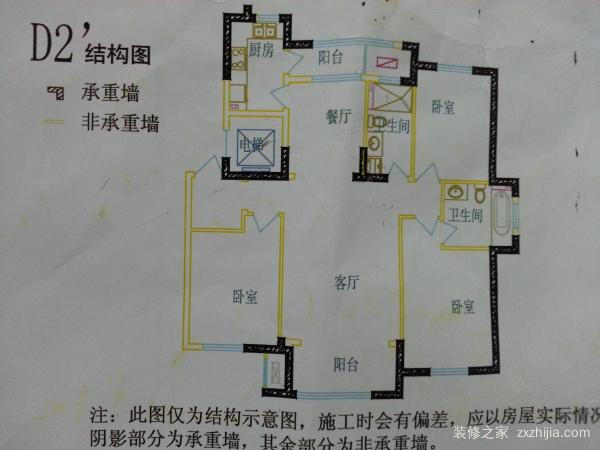The load-bearing wall refers to the wall that supports the weight of the upper floor. The reason why the load-bearing wall cannot be removed is because it supports the weight of the upper floor and is the key to determining the safety of the entire building. Therefore, everyone must pay attention to the protection of the load-bearing wall during the process of renovating the wall. Do not dismantle it casually, which will have an impact on the safety of the living environment. So how do you look at the load-bearing wall ? Xiaobian came to understand how to look at the bearing wall and the load-bearing wall to change the beam. How to look at the load-bearing wall 1. View engineering drawings: Under normal circumstances, people will find the drawings of the house when they purchase the house. If there is a property, they can find the property, thus distinguishing the load-bearing wall from the non-bearing wall, which is represented by the black wall on the engineering drawing. It is a load-bearing wall. The thick solid part in the construction drawing and the wall under the non-bearing beam in the ring beam structure are all load-bearing walls. Non-load-bearing walls are generally marked on the drawings by thin solid or dashed lines. They are made of lightweight, simple materials. Non-bearing walls are generally thin and are only used as partition walls. This is the most direct way to identify. 2. Listening to the sound: The easiest way to identify the load-bearing wall is to tap the wall with your hand. There is a light-weight wall (non-bearing wall) with a crisp echo, and the basic sound of the hitting wall is a rather dull sound. 3, look at the brick structure: brick-concrete structure of the house all two brick walls and a brick vertical wall, are load-bearing walls. Generally, the aerated brick is a non-bearing wall. Walls that have been "empty" by tapping are mostly non-bearing walls. 4, look at the thickness of the wall: 150mm thick partition wall is a non-bearing wall, such as bathroom, kitchen more, 240mm and above is the load-bearing wall. 5, look at the housing parts: the general external wall or the wall shared with the neighbors are load-bearing walls; and the wall of the bathroom, kitchen and storage room, aisle, etc. is about 15cm, is a non-bearing wall. Then, if the beams of the wall and the house are closely combined, it is also the load-bearing wall. Bearing wall change beam considerations First, the change of the load-bearing wall needs to be approved by the national planning and design department, and the construction of the district-level qualified architectural design unit is considered legal reconstruction. Second, the load-bearing wall can be implemented in single-story buildings and multi-storey buildings, but high-rise buildings are not recommended for modification. Third, the concrete must be kept consistent when pouring concrete into the beam and column. Once stopped in the middle, the appearance of the wall will become unsightly. Fourth, the load-bearing wall must be constructed in strict accordance with the construction sequence. The roof waterproofing work should be carried out after the equipment bracket is installed. If there is no bracket, rubber cushions should be placed on the roof waterproof layer, and it should not be installed on the waterproof layer after construction. Equipment and other construction. The above content is what this small series brings to everyone how to look at the load-bearing wall? The introduction of the considerations for the change of the load-bearing wall is for your reference. I believe that after reading this article, you will have a certain understanding of how to look at the load-bearing wall. I hope that I can provide some help to the friends who are working on the renovation of the wall. . For more exciting home improvement content and the latest home improvement information, please continue to pay attention to the decoration home network.
Metal field fence also named grassland fence,are made of hot-dipped Galvanized Steel Wire, offer high strength and tensile strength, provide safety fencing against fierce striking of cattle, horse, deer or goats.
Metal field fence is made with galvanized knot, reasonable design, and beautiful surface, strong corrosion resistance.
Material of metal field fence : Elecrto Galvanized Steel Wire, Hot Dipped Galvanized Steel Wire, PVC Coated Wire, ect.
Wire Diameter of metal field fence : 1.8mm-3.5mm
Space between lines: above 50mm, mulriple 50mm.
Space between cross wire: 50mm-600mm
Type
Mesh
Top and bottom Wire diameter (mm)
Inner wire
diameter(mm)
Roll diameter(mm)
1
7/150/813/50
102+114+127+140+152+178
2.5
2.0
2
8/150/813/50
89(75)+89+102+114+127+140+152
2.5
2.0
3
8/150/902/50
89+102+114+127+140+152+178
2.5
2.0
4
8/150/1016/50
102+114+127+140+152+178+203
2.5
2.0
5
8/150/1143/50
114+127+140+152+178+203+229
2.5
2.0
6
9/150/991/50
89(75)+89+102+114+127+140+152+178
2.5
2.0
7
9/150/1245/50
102+114+127+140+152+178+203+229
2.5
2.0
8
10/150/1194/50
89(75)+89+102+114+127+140+152+178+203
2.5
2.0
9
10/150/1334/50
89+102+114+127+140+152+178+203+229
2.5
2.0
10
11/150/1422/50
89(75)+89+102+114+127+140+152+178+203+229
2.5
2.0
Farm Fence,Grassland Fence,Hinge Joint Fence,Livestock Fencing Anping Bochuan Wire Mesh Co., Ltd. , https://www.wiremeshbocn.com
